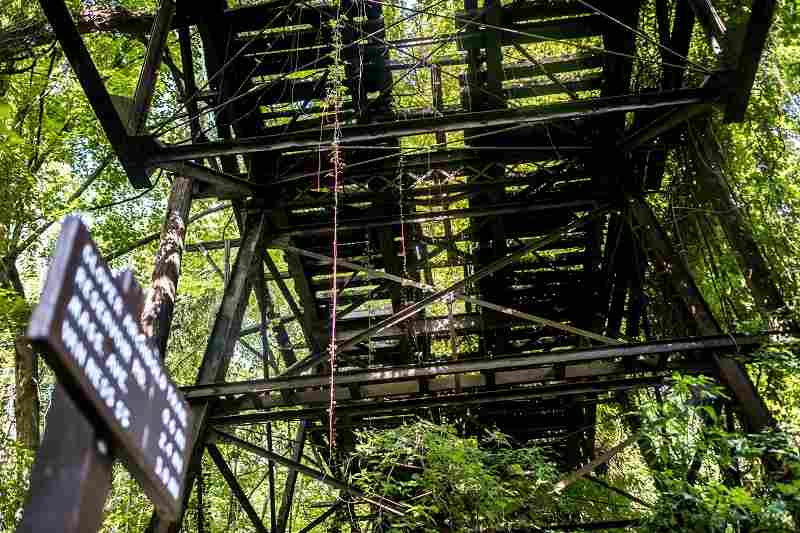Nation’s capital’s last trolley trestle is saved from demolition, for now

The last trolley trestle in the nation’s capital has been condemned but spared from demolition, though its preservation is uncertain.
14:42 JST, September 24, 2022
WASHINGTON – The last remaining streetcar trestle in Washington, D.C., has been saved from demolition, at least temporarily, even as its fate is uncertain amid a renewed push to restore it.
The D.C. Court of Appeals this month vacated a city decision that would have allowed the region’s Metro mass transit system to demolish the 126-year-old bridge it inherited 25 years ago. The ruling was another setback in Metro’s years-long quest to rid itself of the structure, while historic preservationists say the ruling could breathe new life into efforts to turn it into a neighborhood trail.
Metro failed to prove that keeping the structure would cause economic hardship to the transit agency, the court ruled Sept. 15, sending the case back to the Washington mayor’s agent for historic preservation, a city official designated by the mayor’s office to rule on historic preservation law. The mayor’s agent approved the demolition permit in December 2019, but the appeal has stalled that process for years.
“WMATA [Metro] doesn’t have a reason to demolish,” said Rebecca Miller, executive director of the DC Preservation League, which has long challenged the demolition plans and brought the case to court. “They ignored the trestle since they became its owner and this [is considered] demolition by neglect. They have let it rot in violation of D.C. historic preservation law.”
Metro spokeswoman Sherri Ly declined to comment on plans for the trestle, its condition or the legal case, citing the litigation.
Built in 1896, the trestle is listed on the National Register of Historic Places. It’s also on the Washington, D.C., Inventory of Historic Sites as a contributing element of the Glover-Archbold Historic District.
The trestle – located north of the Potomac River in Glover-Archbold Park, west of the Georgetown University campus – was at its busiest in the 1940s. It was a critical passage point for the trolley line that took thousands of passengers from the city’s Georgetown area over the border to Maryland, to the Glen Echo amusement park, which closed in 1968 and has been transformed into an arts and culture center.
The trolley required numerous trestles to carry tracks over stream valleys along the Potomac. It is the last streetcar trestle still standing in the District, officials with the historic preservation office said.
But the trestle is in poor condition and has continued to deteriorate to the point that the pedestrian path beneath it was closed six years ago. In 2018, Metro said an inspection indicated that the 260-foot-long, 20-foot-wide structure was at high risk of collapse.
Metro inherited the trestle in 1997, after it settled a lawsuit brought by the previous owner of the streetcar system, D.C. Transit. The structure has remained unused since the streetcar network shut down in 1962. Metro also owns land near the trestle, which is assessed at more than $500,000, according to court documents.
The agency has sought the trestle’s demolition after unsuccessful efforts to have the city take it over. Metro has also tried to sell or donate it to the National Park Service, Georgetown University and D.C. Water, according to court records.
The court’s ruling is the latest setback for Metro’s efforts to unload the trestle. Before the mayor’s agent’s favorable decision on the demolition permit three years ago, the District’s Historic Preservation Review Board in 2018 denied Metro’s petition for a raze permit, delaying the transit agency’s plans to demolish the structure.
A full restoration could cost upward of $4 million and between $100,000 and $200,000 annually to maintain, court documents indicate. Metro has said demolition would cost about $800,000.
The city’s District Department of Transportation said five years ago it was interested in the trestle’s restoration if it could be reused as part of the city’s growing trail network. The trestle is on a route that DDOT has identified as a potential bike and pedestrian trail, or perhaps as a connection to the C&O Canal Trail.
But DDOT said this past week it no longer is interested in the structure after a study and an independent inspection found parts of the bridge and its footings to be in poor condition. The agency concluded “the bridge no longer serves a transportation function and as such, is not of interest to DDOT to acquire,” DDOT spokeswoman Mariam Nabizad said in an email.
Those in favor of resurrecting the structure say Metro should donate the demolition funds toward restoration, arguing that new transportation money is available through the federal infrastructure law. The site’s historic designation could also make it eligible for federal grants.
A bike and pedestrian path, they say, is even more critical now that the city is opening a new public high school just south of the trestle.
“This trail will help the Palisades, Georgetown and Glover Park people get to this school and will improve the area’s bicycle infrastructure,” said Brett Young, a Palisades resident who has long advocated for restoring the trestle. He said the investment would create a needed path in an area of the city that does not have protected bike lanes.
He said the court’s decision has revived hopes for repurposing the old trestle, validating its historic value to the city. A structure that was used for transportation, he said, could once again be used for that purpose while serving pedestrians and bicyclists.
“We all agree that the bridge is not in good shape,” he said. “It’s a historic landmark and WMATA let it decay. But it has been up more than 120 years and we can restore it to last another 50 to 100 years.”
After the court’s ruling, the mayor’s agent will likely hold hearings, where Metro would need to again make its case for demolition.





